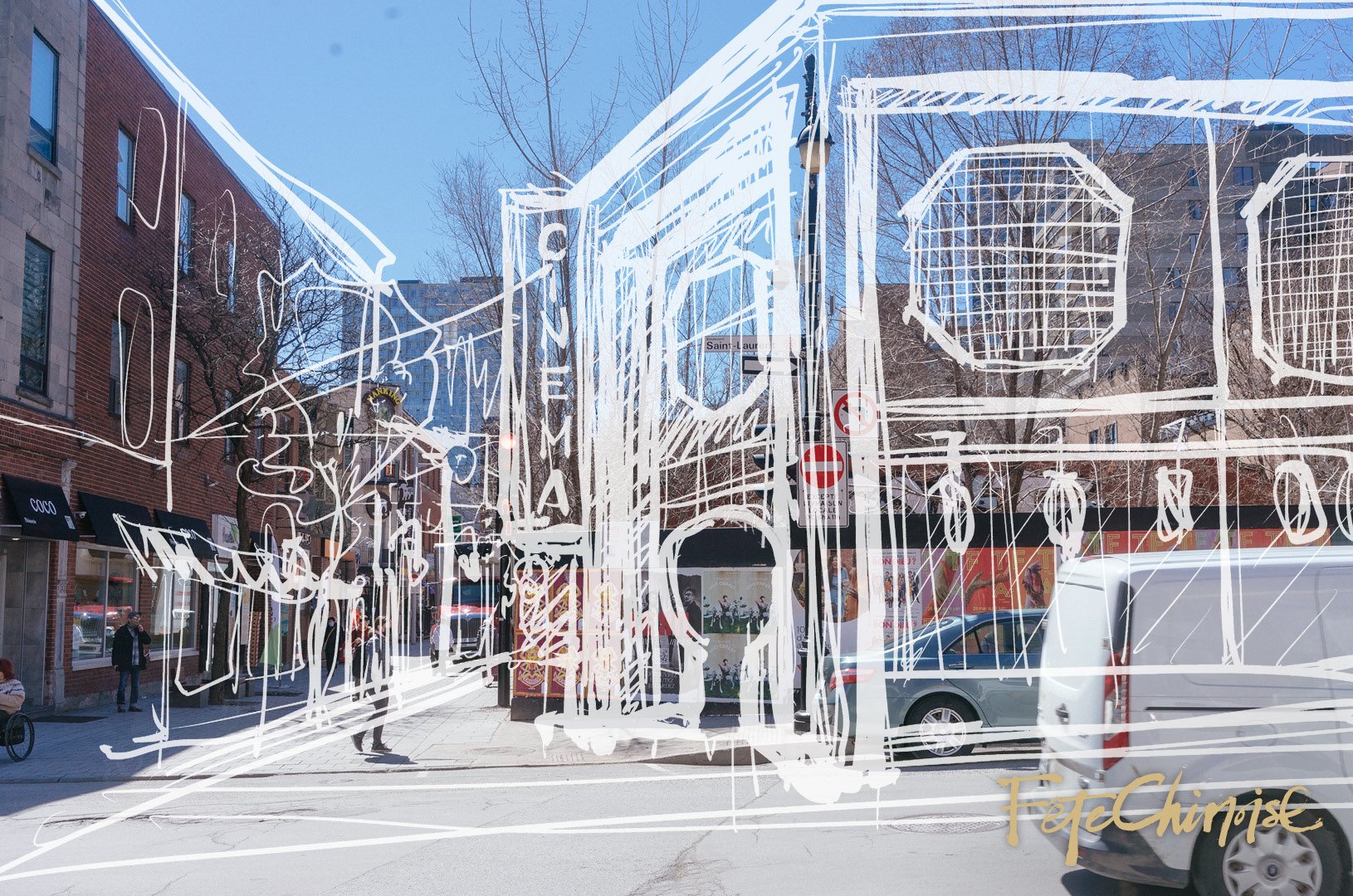Re-Imagining My Chinatown 滿地可唐人街:同源可同心?
English 英: Tim Chin · Chinese 中:Eva Cheung
Photography & Sketches: Tim Chin
《熊抱青春記》 (Turning Red) 是我們一家急不及待觀看的電影。Pixar 動畫、熊貓主角、加拿大背景,給我們無比的親切感。令我動心的,還有另一個更深層次的意義:印象中,這是第一套以亞裔家庭為主角的主流動畫電影。近年,亞裔種族主義引起討論話題,《我的超豪男友》和《尚氣》等電影,均令更多亞裔人材得到主流重視。
THE IMMUTABLE COMPLEXION FROM WHERE WE COME
我們從何處來?
Turning Red, however, is a different type of representation. It tells the story of the 2nd generation immigrant caught between the influences of her heritage and the inevitable draw from her multi-ethnic peers in school. The director, Domee Shi, has described the animated movie as a “Love letter to Toronto” stemming from her own upbringing as a North American child of Asian immigrant parents. A lot of that manifests itself painted against the beautiful pastel vistas of the Canadian Chinatown setting. Though I didn’t grow up in Toronto, it was for me, still an incredibly identifiable reflection of my own childhood.
《熊抱青春記》的不同之處是,電影引述了第二代華裔移民小孩的煩惱、傳統中國家庭及校園多元文化偏差的趣事。導演石之予形容,這是她個人在多倫多成長的寫照,並在唐人街取景。雖然我不是在多倫多長大,但作為華人,我亦能感同身受。
After its release, shallowly critical reviews began surfacing, and I took it personally. “Unrelatable”, “I wasn’t the target market, wasn’t for me”, “3/10! Whole family didn’t like it” — wrote a friend on Facebook, many of the responding comments agreed. I wrestled deeply with these words, not with anger — but with sadness. While it seemed as though there was an acknowledgement from Hollywood that the story of the struggle of the second-generation immigrant merited telling, clearly it also appeared as though the nuances of that narrative were not received with the intent with which they were given. On one hand — by those empowering storytellers like Shi to explore what it’s like to grow up foreign but domestic — I am seen. On the other hand — by those who I had thought to have considered my peers and contemporaries — I am intrinsically misunderstood.
Ironically, the dichotomy between the two brought me to an awakening desire to embrace the immutable complexion from where we come. The combination of heritage and culture is similar to the colour of one’s skin. We are born into it, we don’t choose it — yet, somehow, we still do. On some level, we must interpret and own its value and prominence in our lives while acknowledging they are implicitly thrust upon us. And once I come to terms with this, how do I extol its relevance to my identity within the context around me?
電影上映後,在不同的社交媒體飽受批評。一方面我覺得這套電影,令我和其他在外國出生,但是有着不同文化背景的人一樣,終於被看見 ;另一方面,我覺得我一直被同輩誤解。
恰巧,這次機會令我醒覺自己應該更加關注自己亞裔文化及種族。我們不能選擇自己的種族,但無可厚非,它對我們的身份有一定的價值和影響。我們應該如何在外國環境中,更加關注自身文化呢?
Re-imagining My Chinatown
明天的唐人街會是何樣?
We asked Montreal-based photographer (and trained architect) Tim Chin to take a fresh lens to his Chinatown. The wonderous place of his youth is long gone; nowadays, it just feels sad and neglected.
But if he could, how would he re-imagine it? Here he shares some of his photos and sketches to show us how, with a little love and great design, some of the vitality and beauty could return to this essential place in the community. Is there anyone reading this who could make his vision reality?
我們邀請了著名滿地可攝影師(和訓練有素的建築師) Tim Chin 重新構想他的唐人街。在這專輯,他分享了多幅他鏡頭下的街境和手畫素描,向我們展示如何通過一點點愛和想像力,讓一些活力和美感回歸到這個日久失修的唐人街社區。正在閱讀的你,又可會與Tim 同心修復、活化滿地可唐人街,令他願望成真?
The Editors 編輯們
First, some semantics: Heritage is defined as “valued objects and qualities such as cultural traditions, unspoiled countryside, and historic buildings that have been passed down from previous generations.” Culture, conversely, is “the customs, arts, social institutions, and achievements of a particular nation, people, or other social group.” Heritage comes from the same root word as inheritance or hereditary. Culture comes from the root that means “to tend, guard, cultivate”. Heritage is passive; Culture is active and participatory.
「傳承」是指把有價值的物體和品質,例如傳統、習俗、歷史建築等流傳到下一代,及讓其了解背後的意義。相反,「文化」是指服飾、藝術、社區建設和民族成就。傳承與遺產或世襲來自同一個詞根。文化原意為照料、守護、培育。傳承是被動的,但文化是活躍和可參與的。
Sponsored by FERRIS WHEEL PRESS
The history of Chinatown in Montreal dates back to the early 1900s when the community of immigrants banded together to find sanctuary from racism and encourage a common ethnic connection. Over the years, the concentration of Chinese products, services, groceries and restaurants could be found in this small section of the city south of downtown.
And, after a somewhat antagonistic relationship with the city in the 1960s and 1970s where large sections of the historical Chinatown were annexed in favour of public building projects, there have been small revitalisation efforts and investments in recognizing Montreal’s Chinatown as officially historically significant. That said, the current state of disrepair and the atmosphere of rundown-edness is pervasive, leading many to wonder if we are witnessing the death of what was once a cultural haven.
滿地可唐人街的歷史可追溯到1900年,當時同源的新移民眾集一起,同聲同氣,同心幫助。到後期,愈來愈多不同的華人店舖提供五花百門的產品和服務,凝聚成一個文化社區。隨之,在60和70年代,唐人街在政府的注資下,發展成公共建築項目,保留了古色古香的一面。但目前日久失修的情況令我沒法想像它當時的美態。
Why has it been allowed to come to this state? Can we blame those public projects for pushing Chinese families to the suburbs and away from the city centre? Perhaps it is because the integration of the Chinese people into society at large was relatively successful and the idea of a concentrated sanctuary became less of a collective need? Is the deterioration subsequently reflective of our current generations’ dissociation with our ancestors? Perhaps it is a combination of these factors, as the second generation struggles to identify with what galvanized our parents? Is Chinatown still relevant?
What is clear is that the idyllic portrayal of Chinatown in Turning Red is something of a nostalgic memory that vaguely resembles the decay of today’s reality.
photography: Calven Lee
為甚麼會變到現在那樣?是因為公共建設項目把華人家庭搬到郊區嗎?還是因為華人在唐人街或社區中,已經有一定的凝聚力和社群,所以不再留戀歷史文物?我們這一代,可曾好好珍惜上一代人留給的我們的文化遺產嗎? 抑或是種種的因素,令到我們不再承認自己流着的血統?
反思着「我們從何處來」,到「我們去哪兒」這些問題?歷史遺產和設計帶給我們的意義是甚麼?我們真的要遺棄他們嗎?如果我們也不認同自己的種族文化,誰會幫助我們?
希望之後會有更多像《熊抱青春記》,令更多人去關注自己身份文化背後的意義的電影。
唐人街將來可否繼續承傳我們的文化?我們應該一起探索。
SPonsored by FERRIS WHEEL PRESS


























Toronto-based home cook Veronica Wu takes the crown in MasterChef Canada Season 8, impressing judges Mary Berg, Hugh Acheson, and Craig Wong with her bold, Chinese-inspired dishes. In this exclusive Q&A, Veronica reflects on her journey through MasterChef Canada Season 8 and the challenges of the finale.